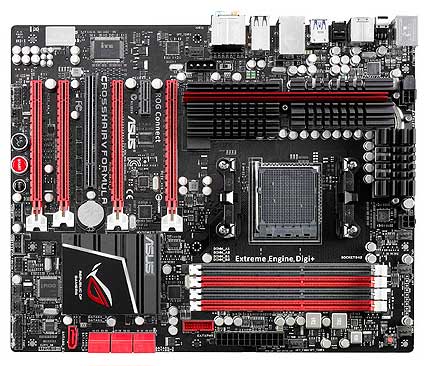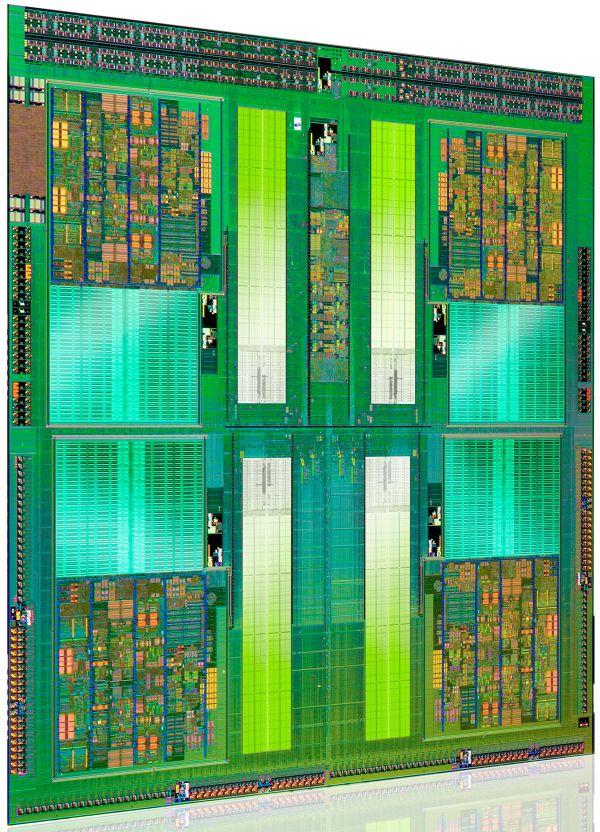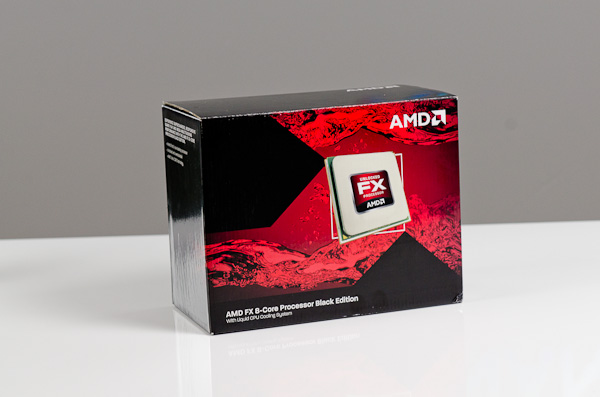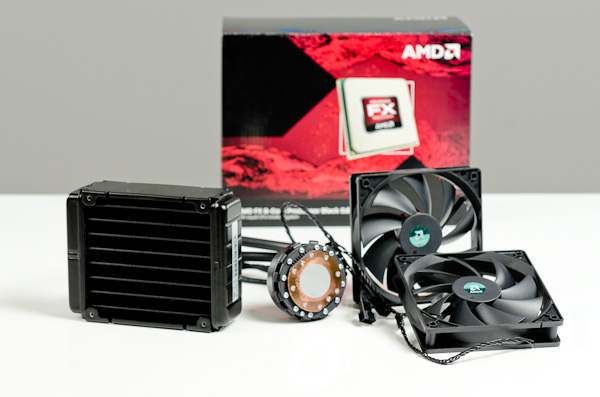The Bulldozer Review: AMD FX-8150 Tested
by Anand Lal Shimpi on October 12, 2011 1:27 AM ESTAMD has been trailing Intel in the x86 performance space for years now. Ever since the introduction of the first Core 2 processors in 2006, AMD hasn't been able to recover and return to the heyday of the Athlon 64 and Athlon 64 X2. Instead the company has remained relevant by driving costs down and competing largely in the sub-$200 microprocessor space. AMD's ability to hold on was largely due to its more-cores-for-less strategy. Thanks to aggressive pricing on its triple and hexa-core parts, for users who needed tons of cores, AMD has been delivering a lot of value over the past couple of years.
Recently however Intel has been able to drive its per-core performance up with Sandy Bridge, where it's becoming increasingly difficult to recommend AMD alternatives with higher core counts. The heavily threaded desktop niche is tough to sell to, particularly when you force users to take a significant hit on single threaded performance in order to achieve value there. For a while now AMD has needed a brand new architecture, something that could lead to dominance in heavily threaded workloads while addressing its deficiencies in lightly threaded consumer workloads. After much waiting, we get that new architecture today. Bulldozer is here.
It's branded the AMD FX processor and it's only available in a single die configuration. Measuring 315mm2 and weighing in at around 2 billion transistors (that's nearly GPU-sized fellas), Bulldozer isn't that much smaller than existing 45nm 6-core Phenom II designs despite being built on Global Foundries' 32nm SOI process. Both die area and transistor count are up significantly over Sandy Bridge, which on Intel's 32nm HKMG process is only 995M transistors with a die size of 216mm2. This is one big chip.
| CPU Specification Comparison | ||||||||
| CPU | Manufacturing Process | Cores | Transistor Count | Die Size | ||||
| AMD Bulldozer 8C | 32nm | 8 | 1.2B* | 315mm2 | ||||
| AMD Thuban 6C | 45nm | 6 | 904M | 346mm2 | ||||
| AMD Deneb 4C | 45nm | 4 | 758M | 258mm2 | ||||
| Intel Gulftown 6C | 32nm | 6 | 1.17B | 240mm2 | ||||
| Intel Nehalem/Bloomfield 4C | 45nm | 4 | 731M | 263mm2 | ||||
| Intel Sandy Bridge 4C | 32nm | 4 | 995M | 216mm2 | ||||
| Intel Lynnfield 4C | 45nm | 4 | 774M | 296mm2 | ||||
| Intel Clarkdale 2C | 32nm | 2 | 384M | 81mm2 | ||||
| Intel Sandy Bridge 2C (GT1) | 32nm | 2 | 504M | 131mm2 | ||||
| Intel Sandy Bridge 2C (GT2) | 32nm | 2 | 624M | 149mm2 | ||||
Update: AMD originally told us Bulldozer was a 2B transistor chip. It has since told us that the 8C Bulldozer is actually 1.2B transistors. The die size is still accurate at 315mm2.
Architecturally Bulldozer is a significant departure from anything we've ever seen before. We'll go into greater detail later on in this piece, but the building block in AMD's latest architecture is the Bulldozer module. Each module features two integer cores and a shared floating point core. FP hardware is larger and used less frequently in desktop (and server workloads), so AMD decided to share it between every two cores rather than offer a 1:1 ratio between int/fp cores on Bulldozer. AMD advertises Bulldozer based FX parts based on the number of integer cores. Thus a two module Bulldozer CPU, has four integer cores (and 2 FP cores) and is thus sold as a quad-core CPU. A four module Bulldozer part with eight integer cores is called an eight-core CPU. There are obvious implications from a performance standpoint, but we'll get to those shortly.
The FX Lineup
There are a total of 7 AMD FX CPUs that AMD is announcing today, although only four are slated for near-term availability.
| CPU Specification Comparison | |||||||||
| Processor | Cores | Clock Speed | Max Turbo | NB Clock | L2 Cache | TDP | Price | ||
| AMD FX-8150 | 8 | 3.6GHz | 4.2GHz | 2.2GHz | 8MB | 125W | $245 | ||
| AMD FX-8120 | 8 | 3.1GHz | 4.0GHz | 2.2GHz | 8MB | 95W/125W | $205 | ||
| AMD FX-8100* | 8 | 2.8GHz | 3.7GHz | 2GHz | 8MB | 95W | N/A | ||
| AMD FX-6100 | 6 | 3.3GHz | 3.9GHz | 2GHz | 6MB | 95W | $165 | ||
| AMD FX-4170* | 4 | 4.2GHz | 4.3GHz | 2.2GHz | 4MB | 125W | N/A | ||
| AMD FX-B4150* | 4 | 3.8GHz | 4GHz | 2.2GHz | 4MB | 95W | N/A | ||
| AMD FX-4100 | 4 | 3.6GHz | 3.8GHz | 2GHz | 4MB | 95W | $115 | ||
| AMD Phenom II X6 1100T | 6 | 3.2GHz | 3.6GHz | 2GHz | 3MB | 125W | $190 | ||
| AMD Phenom II X4 980 | 4 | 3.7GHz | N/A | 2GHz | 2MB | 125W | $170 | ||
The FX-8150, 8120, 6100 and 4100 are what's launching today. The first digit in AMD's FX model numbers indicates the number of cores with the 8150 and 8120 boasting eight, while the 6100 only has six active integer cores (three Bulldozer modules). The FX-4100 features four integer cores. L2 cache scales with core count (2MB per module), while the L3 cache size remains fixed at 8MB regardless of SKU.
North Bridge and L3 cache frequency alternate between 2.0GHz and 2.2GHz depending on the part. TDPs range between 95W and 125W as well, with the FX-8120 being offered in both 125W and 95W versions.
There's only a single Bulldozer die. The 6 and 4 core versions simply feature cores disabled on the die. AMD insists this time around, core unlocking won't be possible on these harvested parts.
The huge gap in clock speed between the 8120 and 8150 are troubling. Typically we see linear frequency graduations but the fact that there's a 16% difference between these two SKUs seems to point to process problems limiting yield at higher frequencies—at least for the 8-core version.
Outside of the quad-core and hex-core Bulldozer pats, the only other FX processor able to exceed the 3.3GHz clock speed of the Phenom II X6 1100T is the 8150. And if you include quad-core Phenom II parts in the mix, only two Bulldozer parts ship at a higher stock frequency than the Phenom II X4 980. Granted Turbo Core will help push frequencies even higher, but these low base frequencies are troubling. For an architecture that was designed to scale to clock speeds 30% higher than its predecessor, Bulldozer doesn't seem to be coming anywhere close.
The entire FX lineup ships unlocked, which allows for some easy overclocking as you'll see soon enough.
Motherboard Compatibility
AMD is certifying its FX processors for use on Socket-AM3+ motherboards. Owners of standard AM3 motherboards may be out of luck, although motherboard manufacturers can choose to certify their boards for use with Bulldozer if they wish to do so. From AMD's perspective however, only AM3+ motherboards with BIOS/UEFI support for Bulldozer are officially supported.
All existing AM2/AM2+/AM3/AM3+ heatsinks should work with the FX processor; they simply need to be rated for the TDP of the processor you're looking to cool.

For this review, AMD supplied us with ASUS' Crosshair V Formula AM3+ motherboard based on AMD's 990FX chipset.
AMD does offer six 6Gbps SATA ports on its 990FX chipset, a significant upgrade from the two 6Gbps ports on Intel's 6-series chipsets. Unbuffered ECC memory is also supported for those who desire the added security, once again a feature not supported on Intel's consumer grade 6-series chipsets.
Despite AMD's trend towards releasing APUs with integrated GPUs (thus requiring a new socket), AMD insists that the AM3+ platform will live to see one more processor generation before it's retired.
AMD's Liquid CPU Cooling System
Alongside its new FX processors AMD is introducing its first branded liquid cooling system manufactured by Asetek.
AMD's cooling system is similar to other offerings from companies like Antec and Corsair. The system is self contained, you never have to worry about adding any more liquid to it.
Attach the cooling module to your CPU socket via a simple bracket, and affix the radiator to your case and you're good to go. The radiator is cooled via two 120mm fans, also included in the box.
AMD doesn't have an exact idea on pricing or availability of its liquid cooling solution, but I'm told to expect it to be around $100 once available. My sample actually arrived less than 12 hours ago, so expect a follow up with performance analysis later this week.
The Roadmap
For the first time in far too long, AMD is actually being very forthcoming about its future plans. At a recent tech day about Bulldozer, AMD laid out its CPU core roadmap through 2014. The code names are below:
Piledriver you already know about, it's at the heart of Trinity, which is the 2—4 core APU due out in early 2012. Piledriver will increase CPU core performance by around 10—15% over Bulldozer, although it will initially appear in a lower performance segment. Remember that final generation of AM3+ CPU I mentioned earlier? I fully expect that to be a GPU-less Piledriver CPU due out sometime in 2012.
Steamroller will follow in 2013, again improving performance (at the core level) by around 10—15%. Excavator will do the same in 2014. AMD believes that these performance increases will be sufficient to keep up with Intel over time, however I'll let you be the judge of that once we get to the Bulldozer performance numbers.
The other thing to note about AMD's roadmap is it effectively puts the x86 business on an annual cadence, in line with what we've seen from the AMD GPU folks. Although AMD isn't talking about what process nodes to expect all of these cores at, it looks like AMD will finally have an answer to Intel's tick-tock release schedule moving forward.























430 Comments
View All Comments
ThaHeretic - Saturday, October 15, 2011 - link
Here's something for a compile test: build the Linux kernel. Something people actually care about.Loki726 - Monday, October 31, 2011 - link
The linux kernel is more or less straight C with a little assembly; it is much easier on a compiler frontend and more likely to stress the backend optimizers and code generators.Chromium is much more representative of a modern C++ codebase. At least, it is more relevant to me.
nyran125 - Saturday, October 15, 2011 - link
Whats the point in having 8 cores, if its not even as fast as an intel 4 core and you get better performance overall with intel.. Heres the BIG reality, the high end 8 core is not that much cheaper than a 2600K. Liek $20-60 MAX> Youd be crazy to buy an 8 core for the same price as an intel 2600K...LIKE MAD!!!
Fiontar - Saturday, October 15, 2011 - link
Well, these numbers are pretty dismal all around. Maybe as the architecture and the process mature, this design will start to shine, but for the first generation, the results are very disappointing.As someone who is running a Phenom II X6 at a non-turbo core 4.0 Ghz, air cooled, I just don't see why I would want to upgrade. If I got lucky and got a BD overclock to 4.6 Ghz, I might get a single digit % increase in performance over my Phenom II X6, which is not worth the cost or effort.
I guess on the plus side, my Phenom II was a good upgrade investment. Unless I'm tempted to upgrade to an Intel set up in the near future, I think I can expect to get another year or two from my Phenom II before I start to see upgrade options that make sense. (I usually wait to upgrade my CPU until I can expect about a 40% increase in performance over my current system at a reasonable price).
I hope AMD is able to remain competitive with NVidia in the GPU space, because they just aren't making it in the CPU space.
BTW, if the BD can reliably be overclocked to to 4.5Ghz+, why are they only selling them at 3.3 Ghz? I'm guessing because the added power requirements then make them look bad on power consumption and performance per watt, which seems to be trumping pure performance as a goal for their CPU releases.
Fiontar - Saturday, October 15, 2011 - link
A big thumbs down to Anand for not posting any of the over-clock benchmarks. He ran them, why not include them in the review?With the BD running at an air cooled 4.5 Ghz, or a water cooled 5.0 Ghz, both a significant boost over the default clock speed, the OC benchmarks are more important to a lot of enthusiasts than the base numbers. In the article you say you ran the benchmarks on the OC part, why didn't you include them in your charts? Or at least some details in the section of the article on the Over-clock? You tell us how high you managed to over-clock the BD and under what conditions, but you gave us zero input on the payoff!
Oscarcharliezulu - Saturday, October 15, 2011 - link
...was going to upgrade my old amd3 system to a BD, just a dev box, but I think a phenom x6 or 955 will be just fine. Bit sad too.nhenk--1 - Sunday, October 16, 2011 - link
I think Anand hit the nail on the head mentioning that clock frequency is the major limitation of this chip. AMD even stated that they were targeting a 30% frequency boost. A 30% frequency increase over a 3.2 GHz Phenom II (AM3 launch frequency i think) would be 4.2 GHz, 17% faster than the 3.6 GHz 8150.If AMD really did make this chip to scale linearly to frequency increases, and you add 17% performance to any of the benchmarks, BD would roughly match the i7. This was probably the initial intention at AMD. Instead the gigantic die, and limitations of 32nm geometries shot heat and power through the roof, and that extra 17% is simply out of reach.
I am an AMD fan, but at this point we have to accept that we (consumers) are not a priority. AMD has been bleeding share in the server space where margins are high, and where this chip will probably do quite well. We bashed Barcelona at release too (I was still dumb enough to buy one), but it was a relative success in the server market.
AMD needs to secure its spot in the server space if it wants to survive long term. 5 years from now we will all be connecting to iCloud with our ARM powered Macbook Vapor thin client laptops, and a server will do all of the processing for us. I will probably shed a tear when that happens, I like building PCs. Maybe I'll start building my own dedicated servers.
The review looked fair to me, seems like Anand is trying very hard to be objective.
neotiger - Monday, October 17, 2011 - link
"server space where margins are high, and where this chip will probably do quite well."I don't see how Bulldozer could possibly do well in the server space. Did you see the numbers on power consumption? Yikes.
For servers power consumption is far more important than it is in the consumer space. And BD draws about TWICE as much power as Sandy Bridge does while performs worse.
BD is going to fail worse in the server space than it will in the consumer space.
silverblue - Monday, October 17, 2011 - link
I'm not sure that I agree.For a start, you're far more likely to see heavily threaded workloads on servers than in the consumer space. Bulldozer does far better here than with lightly threaded workloads and even the 8150 often exceeds the i7-2600K under such conditions, so the potential is there for it to be a monster in the server space. Secondly, if Interlagos noticably improves performance over Magny Cours then coupled with the fact that you only need the Interlagos CPU to pop into your G34 system means this should be an upgrade. Finally, power consumption is only really an issue with Bulldozer when you're overclocking. Sure, Zambezi is a hungrier chip, but remember that it's got a hell of a lot more cache and execution hardware under the bonnet. Under the right circumstances, it should crush Thuban, though admittedly we expected more than just "under the right circumstances".
I know very little about servers (obviously), however I am looking forward to Johan's review; it'd be good to see this thing perform to its strengths.
neotiger - Monday, October 17, 2011 - link
First, in the server space BD isn't competing with i7-2600K. You have to remember that all the current Sandy Bridge i7 waste a big chunk of silicon real estate on GPU, which is useless in servers. In 3 weeks Intel is releasing the 6 core version of SB, essentially take the transistors that have been used for GPU and turn them into 2 extra cores.Even in highly threaded workloads 8150 performs more or less the same level as i7-2600K. In 3 weeks SB will increase threaded performance by 50% (going from 4 cores to 6). Once again the performance gap between SB and BD will be huge, in both single-threaded and multi-threaded workloads.
Second, BD draws much higher power than SB even in stock frequency. This is born out by the benchmark data in the article.